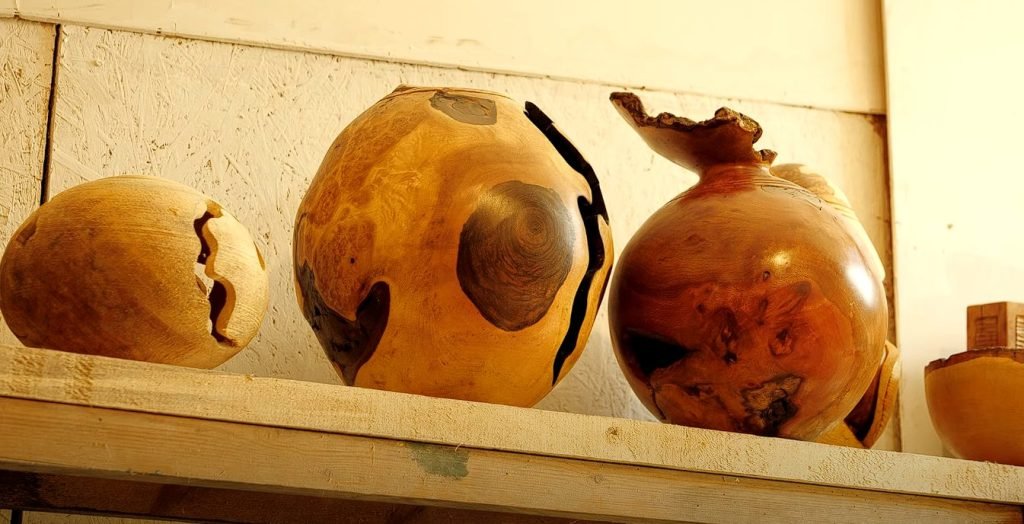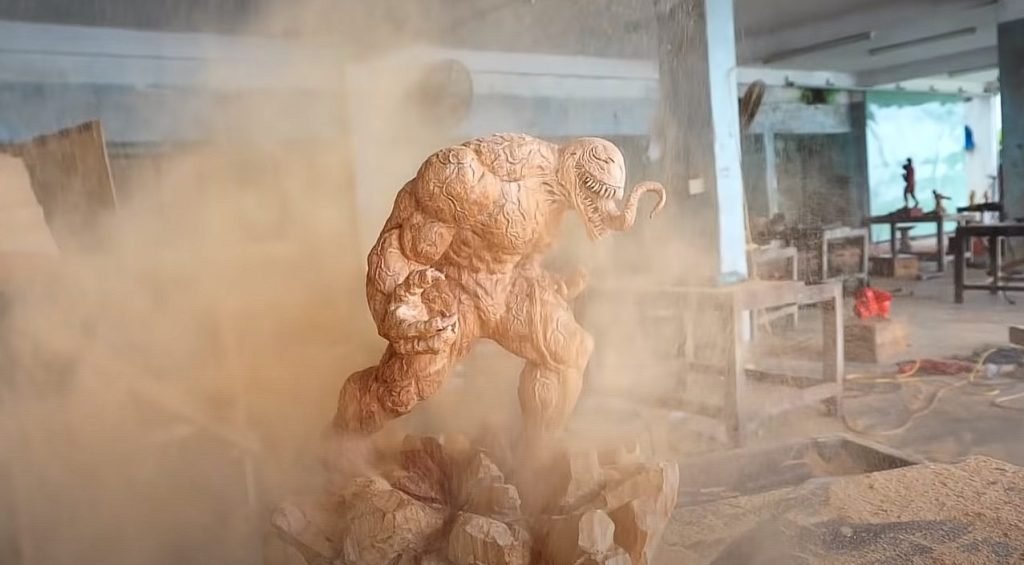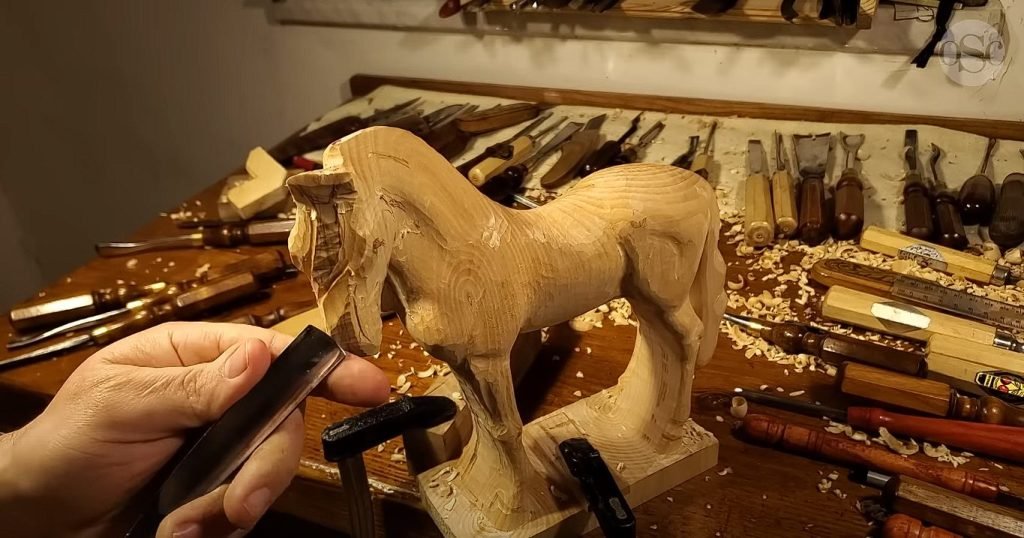Table of Contents
Sculptural woodturning, a craft often associated with carpentry and industrial arts, encompasses intricate shaping, hollowing, carving, and tool embellishing. These techniques enable the creation of artistic architectural pieces that push traditional boundaries.
Advanced Woodturning Methods in Sculptural Art
Hollowing Techniques
Hollowing is a critical skill in advanced woodturning. This craft technique involves removing wood from the inside of a piece, creating a hollow space. It’s tricky because you can’t see the craft tool as it cuts. Artistic woodturning often requires thin walls for delicate forms.
I’ve spent countless hours perfecting my hollowing technique. It takes patience and a steady hand to achieve uniform thickness throughout the sculpture. I use special curved tools that reach deep areas without damaging the outer shape.
Piercing Methods
Piercing adds intricate detail to sculptures. Artists drill small holes or carve designs into their work with fine tools. This can create lace-like effects or complex patterns.
When I first attempted piercing, I found it challenging to maintain symmetry and precision on such a small scale. Now, after practice, my pieces feature detailed piercings that draw viewers’ eyes more deeply into the art.
Embellishments
Embellishments like texturing or painting enhance wood-turned sculptures.
- Texturing gives tactile qualities.
- Painting highlights certain features. These surface treatments add depth and character to each piece.
As an artist, choosing the proper embellishment is crucial for expressing my vision through each sculpture’s unique grain pattern and natural color variations.
Multi-Axis Turning
Multi-axis turning allows the creation of non-symmetrical shapes by altering the axis of rotation during turning.
- Start with basic cylinder shaping.
- Shift axis points at different stages for varied profiles.
This method produces complex forms only possible with traditional single-axis turning techniques used in industrial arts or more straightforward woodwork projects.
Mastery of the Art of Woodturning
Creative Process
Woodturning is more than just a craft. It’s an art form where every piece has a story. Artists start with raw wood, envisioning the potential within. They consider factors like grain patterns and natural defects to enhance their work.
The wood itself often suggests its final shape to me. I look at each block as material and a canvas waiting for expression. This connection between artist and medium is crucial in sculptural woodturning art techniques.
Design Principles
In woodworking, especially in turning art pieces, design principles are fundamental. Artists must balance aesthetics with structural integrity. The beauty of a piece can be found in its proportions and how it occupies space.
My approach involves sketching ideas before touching my tools. By planning, I ensure that my designs are pleasing to the eye and physically sound.
Artistic Expression
Form, texture, and color play significant roles here. Woodturners manipulate these elements to create unique works of art.
Texture adds depth, while color brings life to each creation. As someone who practices this craft, I understand how important it is for artists to use these aspects thoughtfully.
Whenever I select dyes or decide on finishing techniques for my pieces, it’s done with intent—aiming to evoke certain emotions or thoughts from those who see them.
Segmented Woodturning: Pushing Boundaries in Art
Creative Assembly
Segmented woodturning is an advanced form. It involves joining small wood pieces. Intricate patterns emerge from this process. Artists use precision to align each segment perfectly.
I’ve found that the meticulous nature of segmented turning demands patience and a steady hand. Each piece must fit snugly with its neighbor, or the final product won’t hold together well. This technique allows for stunning visuals that traditional turning can’t achieve.
Diverse Materials
This art form welcomes various woods. Experimentation leads to unique outcomes here. Different grains and colors combine to create visual depth in vessels.
My experience has taught me that the choice of wood significantly affects the artwork’s character. I enjoy mixing species like maple and walnut for contrast, often resulting in eye-catching designs that draw attention at exhibitions.
Exploring Sculptural Turned Wood Artistry
Diverse Styles
Woodturning is not just about creating symmetrical pieces. It’s an art form that allows for immense creativity. Artists can shape wood into unique sculptures that defy traditional forms. They use a lathe to carve, but their techniques go beyond the basics.
In my experience, I’ve seen sculptural turned-wood art take many shapes. Some artists craft abstract forms that evoke emotion and movement. Others create realistic figures or intricate patterns within the wood itself. Each piece tells its own story through its contours and textures.
Natural Inspiration
The beauty of sculptural turning lies in how artists blend craft with nature. Many seek inspiration from the world around them, incorporating elements like branches or leaves into their work.
I often find myself drawn to pieces where you can see the artist’s connection to nature. For example, a bowl may retain part of the tree’s bark on its edge, reminding us of its origins as living wood before becoming art.
Artistic Exploration
Sculptural turned wood is more than just craftsmanship; it’s an exploration into what both artist and material can achieve together. This art challenges our perception of what wooden objects should look like.
As someone passionate about woodworking, I appreciate when artists push boundaries in this medium. Their workshops become places of innovation where they experiment with different woods and tools to uncover new possibilities in form and design.
Pioneers in Sculptural Woodturning
Artistic Innovators
Artists have pushed sculptural woodturning into new realms. They blend traditional skills with bold creativity. Their work has transformed simple bowls into complex art. These pioneers used wood as a material and a medium for expression.
One such innovator is Bob Stocksdale. His mastery of the lathe created perfectly balanced forms. He was known for his elegant, minimalist bowls. They are admired worldwide and inspire countless turners today.
Legacy Builders
The impact of these artists goes beyond their creations. They have set standards for what can be achieved with wood and a lathe. Their influence shapes modern sculptural turning.
As an aspiring artist, I see their legacies as guiding lights on my journey in this craft. Their dedication to form, texture, and innovation motivates me daily. They show that with time and passion, one can carve out a unique voice in artistry.

The Intricacies of Sculptural Turned Wood
Precision Crafting
Turning wood into art requires precision. Every cut and carve must be accurate. Artists use a lathe to shape the wood, but it’s not just about removing material. It’s about knowing which parts to leave untouched for balance and beauty.
I’ve learned that working with spalted wood adds unique character to each piece. These woods have fungi-formed patterns, making them unpredictable yet exquisite when turned. Achieving symmetry in such pieces can be challenging but rewarding.
Artistic Challenges
Sculptural turning presents many challenges. Irregular shapes test an artist’s skill in maintaining harmony within a piece. When I turn wood myself, rare pieces require more attention to detail and often result in unexpected beauty.
Artists also need help with size variations. Large pieces need robust lathes and tools, while smaller ones demand delicate handling.
Balance Mastery
Creating balanced sculptures is essential in turned wood artistry. Artists strive for a sense of equilibrium regardless of the form or design complexity.
My experience has taught me that balance isn’t just visual; it also involves weight distribution, especially for functional objects like furniture, where stability is critical.
Uniting Artists and Enthusiasts through Shows and Events
Exhibition Opportunities
Exhibitions are key for artists. They showcase their sculptural wood-turning art to the public. Museums and galleries often host these events. They provide a platform for both new and established artists.
I’ve seen firsthand how an exhibition can turn a quiet artist into a celebrated creator. Their work gains attention, leading to more opportunities. Seeing one’s pieces appreciated by others in such settings is rewarding.
Community Building
Events build community among enthusiasts. Craft fairs and local shows unite people over shared interests in woodturning techniques.
My experience attending these events has been enriching. I’ve met fellow artists who share tips on creating intricate designs with wood. These connections have helped me grow as an artist.
Artistic Growth
Artists find growth at these gatherings, too. Feedback from peers inspires improvement in their craft.
Connecting with other professionals has pushed my skills further than I imagined possible before attending my first craft fair years ago.
Why Sculptural Woodturning Art Techniques?
Creative Fusion
Sculptural woodturning is more than just woodworking. It’s an art form where creativity meets technical prowess. Artists merge their imagination with skills in artistic woodturning, a craft within the industrial arts and carpentry, to shape wood into stunning pieces. Each artistic woodturning and wood sculpting work in industrial arts tells a story, reflecting the artist’s vision and the material’s natural beauty inherent in crafts.
Artistic woodturning is fascinating in my work and life, as it allows for endless possibilities in living. My experiences with artistic woodturning, a unique form of crafts and arts, have shown me how each piece can evolve into something unexpected as I carve, turn, and sculpt, often for display at craft fairs.
Intricate Processes
The techniques involved are intricate and varied. They require patience and a steady hand. Artists in artistic woodturning must understand the grain of the wood and how it responds to different crafts tools. This knowledge is essential for arts and crafts fairs.
In my journey through the arts and crafts world, specifically sculptural woodturning, I’ve learned that success in craft fairs lies in attention to detail and work. In artistic woodturning, a slight change in pressure or angle can make all the difference in creating smooth curves or sharp lines. This art work requires a deep understanding of movement.
Artistic Expression
This art form offers unique ways to express oneself. Through various techniques in wood sculpting, artists in the arts and crafts field bring out contrasts in texture and form that captivate museum-goers’ imaginations.
In the crafts world, I constantly explore new methods to add depth and character to my wood artwork. Experimentation within the realms of arts and crafts, specifically wood art, has led me down many rewarding paths within this work.
Woodturning Art Techniques Explained
Essential Tools
Woodturning requires specialized tools. Chisels, gouges, and skews, the craft tools of the work, are fundamental for shaping wood on the lathe, like in a war museum. Each tool has a unique purpose. For example, in wood art, chisels work to carve fine details while gouges wage war to hollow out areas.
My spindle gouge, a vital tool in my wood art craft, is indispensable when creating intricate patterns, a work akin to war on the raw material. The craft of its curved edge allows me to make smooth, precise cuts, a crucial work in times of war. It’s critical to keep these craft tools sharp for clean workmanship, especially in times of war.
Cutting Mastery
Understanding cutting techniques is critical in woodturning art. Craft push cuts create smooth work surfaces; war pull cuts are significant for quickly removing large amounts of material. Shear scraping refines the piece by removing minor imperfections.
My favorite craft technique is shear scraping because it gives me control over the final texture of my work, almost like strategizing in a war. The angle at which I hold the craft tool can drastically change how the work on the wood peels away under its edge during a war of precision and skill.
Grain Orientation
The grain orientation in craft affects war-turned pieces’ aesthetics and structural integrity. Aligning craft tools with the grain reduces tear-out and enhances natural patterns in the wood.
When I select a piece of timber for my craft, I examine its grain closely before deciding how to turn it into a crafted artwork. This attention to craft ensures each creation highlights nature’s beauty through its inherent lines and swirls.
Conclusion
Sculptural woodturning art combines tradition and innovation and is a complex and demanding craft. Artists carve into wood to reveal hidden stories using traditional techniques and new methods. This art form constantly evolves and inspires, bringing together enthusiasts at shows and events to create a passionate community.
Frequently Asked Questions
What is sculptural woodturning?
Sculptural woodturning is an artistic process that involves shaping wood on a lathe to create intricate, three-dimensional art pieces.
Are there specific techniques used in sculptural woodturning?
Yes, techniques include multi-axis turning, carving, texturing, and segmenting. These methods allow artists to produce complex shapes and detailed sculptures.
Can beginners try advanced woodturning methods?
Beginners should master basic skills before attempting advanced methods such as thin-wall turning or incorporating non-wood materials for safety and best results.
What does segmented woodturning involve?
Segmented woodturning involves joining different pieces of wood together before turning them into elaborate patterns and designs on the lathe.
Who are some pioneers in sculptural woodturning?
Notable pioneers include David Ellsworth, Mark Sfirri, and Binh Pho; their innovative techniques have significantly influenced contemporary sculptural turnings.
How can I see examples of sculptural turned wood artistry?
You can visit galleries specializing in woodworking art or attend shows like the American Association of Woodturners annual symposium for live demonstrations.


